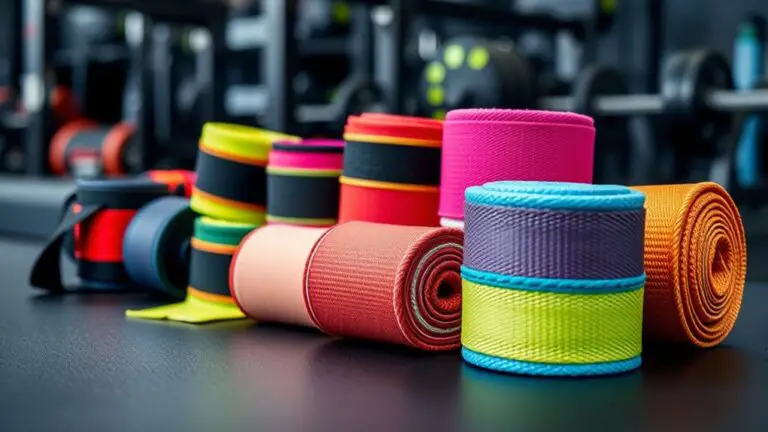The Best Full-Body Workouts for Maximum Strength Gains

To build maximum strength, full-body workouts are your best bet. They engage multiple muscle groups, promoting balanced development and enhancing metabolism. Key exercises like squats, deadlifts, push-ups, and pull-ups will strengthen your entire body. Whether you’re a beginner or advanced, you can tailor your workout plan to fit your needs. Focus on maintaining form and consistency to see significant gains. Stick around, and you’ll discover tips on maximizing your workouts and tracking your progress effectively.
Understanding Full-Body Workouts and Their Benefits

Full-body workouts are a powerhouse approach to fitness, delivering extensive strength gains in a time-efficient manner. If you’re looking for a benefits overview, these workouts maximize your efforts by engaging multiple muscle groups simultaneously. This means you can build strength and improve your overall fitness without spending hours in the gym.
With the right workout frequency, you can see significant improvements in just a few sessions per week. By targeting all major muscle groups, you promote balanced development and help prevent injuries. Plus, full-body workouts can be easily adjusted to suit any fitness level, making them accessible for everyone.
Incorporating these workouts into your routine not only boosts your strength but also enhances your metabolism, leading to improved fat loss and endurance. So, if you’re short on time and want results, full-body workouts are your go-to solution for achieving your fitness goals.
Essential Exercises for a Full-Body Strength Routine
When you’re planning a full-body strength routine, it’s essential to include a variety of exercises that target all major muscle groups. Focusing on compound movements and bodyweight exercises will help you build strength efficiently while engaging multiple muscles at once. Here are five vital exercises to incorporate:
- Squats: A powerful lower-body move that also engages your core.
- Deadlifts: Excellent for strengthening your back, hamstrings, and glutes.
- Push-Ups: A fantastic upper-body exercise that works the chest, shoulders, and triceps.
- Pull-Ups: Great for your back and biceps, using only your body weight.
- Planks: Core stability is vital, and planks target your abdominals and lower back. Incorporating exercises like Knee-to-elbow raise can provide effective modifications for those who may struggle with traditional movements.
Sample Full-Body Workout Plans for Different Fitness Levels

Building on those foundational exercises, it’s time to put together some workout plans that cater to various fitness levels. If you’re just starting out, try a beginner routine that includes bodyweight squats, push-ups, and planks. Aim for three sets of 10-12 reps, focusing on form and control.
For those at an intermediate level, incorporate dumbbell exercises like shoulder presses and deadlifts. You can challenge yourself with four sets of 8-10 reps, gradually increasing the weight.
If you’re advanced, add complexity with advanced modifications such as barbell squats, kettlebell swings, and explosive movements like burpees. Opt for five sets of 6-8 reps, pushing your limits while maintaining proper technique.
No matter your fitness level, consistency is key. Stay committed, and you’ll see those strength gains in no time!
Tips for Maximizing Your Full-Body Workout Efficiency
To get the most out of your full-body workout, focus on planning and execution. Consider these tips to maximize your efficiency and boost strength gains:
- Schedule your workouts: Find a consistent time that fits your lifestyle to enhance workout timing.
- Prioritize compound movements: Exercises like squats, deadlifts, and bench presses engage multiple muscle groups, giving you more bang for your buck.
- Fuel your body: Implement nutrition strategies by eating a balanced meal with protein and carbs before and after workouts to fuel performance and recovery.
- Stay hydrated: Drink plenty of water to maintain energy levels and optimize muscle function during your sessions.
- Limit distractions: Create a focused environment by minimizing interruptions, allowing you to fully concentrate and push your limits.
- Monitor your intensity: Aim for at least 70% of maximum heart rate during workouts to ensure you are challenging your body effectively.
Tracking Progress and Adjusting Your Full-Body Training Plan

As you commence your full-body training journey, tracking your progress becomes essential for achieving your strength goals. Start by establishing clear progress metrics, like the amount of weight lifted, the number of reps completed, or even workout duration. This data not only keeps you accountable but also helps you identify trends in your performance.
Regularly reviewing these metrics allows you to make informed workout adjustments. If you find certain exercises becoming too easy, it’s time to increase the weight or change the variation to challenge your muscles further. On the flip side, if you’re struggling to maintain form, consider reducing the load or modifying the movement.
Frequently Asked Questions
How Often Should I Do Full-Body Workouts Each Week?
You should aim for full-body workouts about 2 to 3 times a week. This frequency allows your body to build strength while providing enough recovery time between sessions. Listen to your body; if you feel overly fatigued or sore, consider adjusting the intensity or frequency. Staying consistent is key, but so is giving yourself space to recover. Remember, it’s not just about how often you train, but how effectively you recover!
Can Beginners Safely Perform Full-Body Workouts?
Did you know that nearly 80% of fitness beginners give up within their first year? But you can beat the odds! Yes, beginners can safely perform full-body workouts. Start with beginner modifications to lower workout intensity, focusing on mastering form instead of lifting heavy weights. Gradually increase your intensity as you gain confidence and strength. Remember, consistency is key, and each workout brings you closer to your goals—so keep pushing forward!
What Should I Eat Before a Full-Body Workout?
Before a full-body workout, you’ll want to focus on pre workout nutrition that fuels your body. Opt for energy boosting snacks like a banana with peanut butter or Greek yogurt with berries. These options provide the carbs and protein you need to power through your session. Remember, eating about 30 to 60 minutes before exercising can make a huge difference in your performance, keeping your energy levels high and your motivation strong!
Are Full-Body Workouts Suitable for Weight Loss?
Picture your body as a furnace, burning fuel to create energy. Full-body workouts can indeed be your ticket to weight loss, especially when paired with a caloric deficit. These workouts not only torch calories during the session but also provide a metabolism boost that keeps your body burning long after you’ve finished. So, lace up your sneakers, embrace the challenge, and watch as you sculpt your physique while shedding those extra pounds.
How Can I Avoid Injury During Full-Body Workouts?
To avoid injury during full-body workouts, focus on maintaining proper form throughout each exercise. Start with a thorough warm-up to prepare your muscles and joints, which can greatly reduce the risk of strains. Listen to your body; if something feels off, don’t hesitate to adjust or take a break. Staying hydrated and incorporating rest days is vital too. Remember, it’s about progress, not perfection, so take your time and enjoy the journey!





